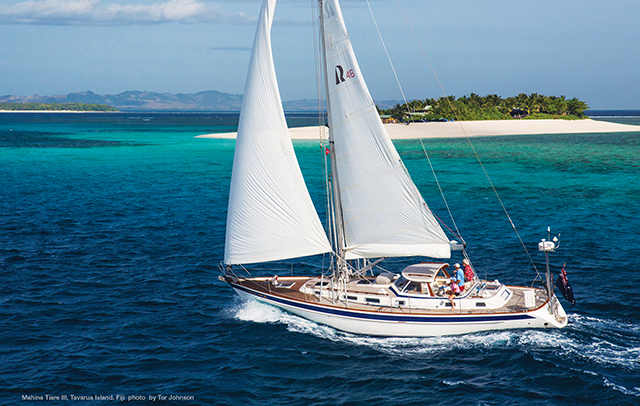A look back at our boat and gear, what worked and what didn’t (published April 2013)
In 1995, when we ordered Mahina Tiare III, our Hallberg-Rassy 46, we were in Patagonia, headed to Antarctica in the midst of our seventh year of leading sail-training expeditions aboard our 1983 Hallberg-Rassy 42. We had searched the world for a larger, faster vessel that could comfortably accommodate eight people and withstand hundreds of thousands of miles of ocean passagemaking; frequently in challenging high-latitude conditions.
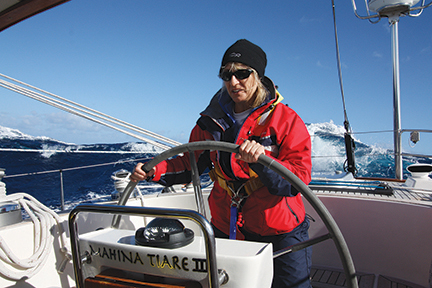
student at the helm
It’s currently cyclone season in the South Pacific and we’ve just left MT III in Auckland, New Zealand after completing our 15th season of sail-training aboard her. She’s sitting quietly on the hard, dressed in her full boat cover, though before leaving we spent two weeks working on projects that required repairing or replacing gear along with planning future gear replacements. This was also the perfect time to reflect on what has worked well and what has not.
DESIGN AND CONSTRUCTION
Overall, we have been amazed at how well the boat has held up to sailing 10,000 miles a year. If we were to change anything in the design, we would carry the beam a little further aft, as German Frers did in the HR 48, but this is a very minor point. We’ve been pleased to be able to sail upwind and downwind in a very wide range of conditions comfortably, without pounding at up to 209 miles per day.
The depth of the hull means that downwind speed is more limited than on a design with a flatter bottom, but it also equates to less pounding upwind and a large volume below the waterline for tankage (265 gallons water, 275 gallons fuel) and storage for food and spare parts.
The Divinycell closed-cell PVC foam core insulation above the waterline and in the deck and cabin has made life warm and dry when we’ve been surrounded by ice above Spitsbergen or in Alaska. The two identical Webasto forced-air furnaces have required servicing every 5 to 7 years but are very fuel-efficient, quiet and clean. We love them.
One of our favorite design features of the HR 46 is the shelter that the optional rigid hardtop dodger provides. The hard top also provides a substantial handhold when going forward and a solid place to stand when furling the mainsail. The center section of the windshield opens, which really funnels the wind through the cockpit when not going upwind. After 15 years, the rubber seal has become brittle, so replacing it is on the list for this year. Speaking of ports, our 12 Lewmar opening ports have never leaked and have their original seals. The Lewmar opening hatches, on the other hand, have been a challenge to keep from dripping in heavy weather, so to avoid this we tie clear vinyl covers over them before the start of the passage. We’re now replacing several of the hatches for the third time.
STEERING
The Whitlock (now Lewmar) Mamba steering has proven to be very dependable. It works on a series of stainless tubes, bronze bevel gears and U-joints and after 100,000 and 150,000 miles we’ve had some shims pulled out to make up for the wear in the bronze teeth and replaced a few of the U-joints. The semi-balanced rudder means minimum helm input is required to steer the boat even at speeds over 12 knots.
MAST AND RIGGING (including winch bases, jammers)
The deck-stepped Selden mast has worked out very well. We replaced the standing rigging at 10 years, 100,000 miles and will replace it again when we return to Sweden in 2015. The cast aluminum gooseneck fitting hasn’t failed, but after 150,000 miles it became a little sloppy from wear so we replaced it. Originally we had an Aqua Signal Tri-color anchor light on the masthead and every few months of passagemaking the bulb would burn out, seemingly always mid-passage. We replaced it with a Lopolight LED fixture and although we appreciate the much lower amperage draw, we’ve twice had to replace the unit. We replaced the original Selden wire- to-rope halyards with New England Ropes Sta-Set to avoid wear on the mast sheaves and rigging and generally replace all the running rigging, which is Sta-Set, every 3 to 4 years or 30,000 to 40,000 miles.
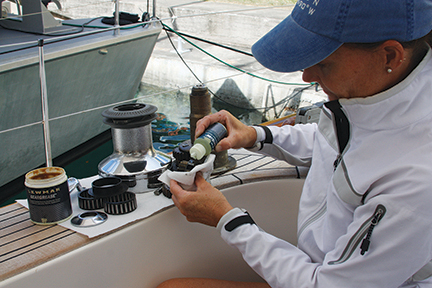
Our nine Lewmar winches have held up fairly well with only the base on one of our two Lewmar 66 splitting and requiring replacement. A Lewmar mainsheet jammer recently broke as the plastic is now brittle so we’ve chosen to replace the other two jammers with the latest, improved Lewmar model.
SAILS

Our original Elvstrøm sails lasted 10,000 miles. We’ve recently ordered our third main and genoa from Port Townsend Sails whose sails have been lasting us on average 40,000 miles and four years. Each time we’ve ordered new sails we’ve done extensive research on newer fabrics, but for longevity, we’ve always ended up ordering top quality Dacron®.
With each sail order, we’ve provided extensive, documented feedback to sailmaker Carol Hasse with changes and upgrades. This feedback has meant that each generation sail lasts longer than the previous. A method of preventing the battens from poking through the sail is to sew large circular patches of TopGun, a polyester duck, at the inboard end of the batten pockets. Another improvement to the last mainsail was to have Dacron® sticky-back tape sewn over the wide seams of triple stitching. This way the panel stitching has been protected from both UV and downwind chafe against shrouds. The sail repair tape lasts three years before it suffers UV deterioration, but the original seam stitching underneath it is perfect. This saves needing to have the main re-stitched after 2 to 3 seasons.
The removable storm cutter stay and hank-on storm staysail has been deployed eight times in sustained winds over 45 knots and once when we blew out our headsail as we were punching into a short chop while rounding northern Scotland. It’s a simple system that’s very manageable in heavy weather and even allows for foredeck dinghy stowage. Our storm trysail has only been needed, other than for teaching purposes, six times when the triple-reefed main was definitely not small enough for handling sustained winds over 40 to 45 knots.
After a frustratingly slow Atlantic crossing one year we ordered an asymmetric cruising spinnaker but we’ve been surprised at how few times it has been hoisted. The HR 46 sails very well in light air with a 125% genoa therefore making the window of opportunity for the cruising chute only between 6 and 12 knots.

We started out with a Pfaff 130 and upgraded to a Sailrite Ultrafeed LSZ-1 sewing machine onboard which has proved invaluable many times, especially when our sails are past 30,000 miles. We’ve also used these machines for sewing awnings, lee cloths and covers, although Amanda finds she can’t sew light fabric on the Sailrite.
WINDLASS AND GROUND TACKLE
The 75 lb CQR and 44 lb Delta anchors, carried on twin bow rollers, have worked superbly even when set in deep and exposed anchorages. Our 250’ of 3/8” chain requires galvanizing every 2 to 3 years in tropical waters and we’ll replace it for the third time upon sailing MT III to the U.S. in 2014. We replaced the original Lofrans 24-volt, 1200 watt Tigress windlass at 10 years and this year found the seals and bearings have again severely worn out to beyond repair. Undoubtedly, I should have taken note of the muddy drips occurring below and serviced it sooner. After considerable research we chose a more substantial, all stainless steel Maxwell windlass. Although it uses a similar electric motor, the shaft and gears are much heavier.
LIFERAFT
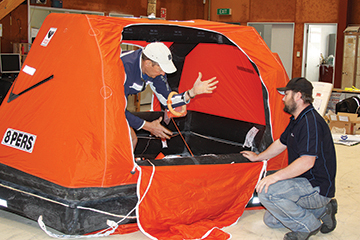
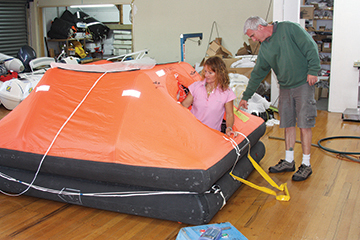
Our original 8-man Autoflug raft and sturdy stainless cradle was a factory option, and when mounted just forward of the dodger windshield was a perfect fit. At 14 years of life, the liferaft repack agency in Auckland requested annual inspections instead of bi-annual. When I calculated the annual servicing cost over two years, I figured we’d be better off with a new raft that had a three-year repack schedule. As Autoflug is now out of production, we now have to balance raft quality, weight, size, features and fit against ease of finding repack stations worldwide. We decided upon a Viking RescYou Pro, slightly larger and heavier, but self-righting and featuring a boarding platform.
DINGHY AND OUTBOARD
The Avon RIB345 we purchased 16 years ago is still holding up and although the fabric is getting thin it still holds air. The fiberglass bottom and transom are in such great shape that I’m considering having the hull “re-tubed” in New Zealand. Our current Yamaha 15 horsepower two-stroke engine has never broken down or stopped in 10 years. Although four-stroke engines are quieter, slightly cleaner and more fuel-efficient, the additional weight plus difficulty finding parts and service in developing countries will send us looking for another two-stoke model if the current motor should ever die.
ELECTRONICS
(ST60, Radar, AIS, Depth)
The simple and now dated Autohelm ST50 depth, speed and wind instruments have only required a new masthead wind transducer at 120,000 miles. The original Autohelm 7000 autopilot has only once needed repairs to the CPU but, since we operate as a sail-training vessel, which means someone is always actively steering, the autopilot gets little use.
The Raytheon R20XX radar lasted nine years before the masterboard died and Raymarine informed us that replacement parts were no longer available. The Raymarine C-80, 48-mile radar/chartplotter that we upgraded to hasn’t required service or repair in six years. We installed a Raymarine AIS receiver when they were first available and last year upgraded to an AIS 650 transceiver, which we certainly appreciate.
 COMMUNICATIONS
COMMUNICATIONS
Although we installed an ICOM M800 SSB after taking delivery, we’ve used it only on rare occasions to relay weather information to other yachts and to check into a net while on passage as a crew teaching exercise. I considered installing a Pactor modem and utilizing Sailmail for email communications and GRIB weather files but chose to go the satellite route instead.
Although we installed the INMARSAT-C unit used on MT II, our main communication is an Iridium satellite phone utilizing UUPlus compression service. Last year, we upgraded to the newer, smaller and more waterproof 9555 after 14 years of service on the original Iridium 9505 phone. For the first ten years we relied on a stern pulpit-mounted antenna but once we mounted the antenna on a newly installed radar pole, we found the signal to be stronger with almost no dropped calls. I use pre-paid cards with no monthly minimums and UUPlus.com compression service, which saves us at least 60-percent on airtime charges.
ENGINE
A diesel generator was never seriously considered when we ordered MT III, as I really wanted to keep the boat as simple as possible and knew, from talking with hundreds of cruisers, that small auxiliary diesel generators were frequently cited as the most problematic equipment on board. If we felt the need for air conditioning (our ten Hella Turbo fans have proven to be a simple and less costly solution), then an AC generator would have been on our original options list. As an alternative, I immediately replaced the standard 24-volt 50 amp house alternator with a 115 amp Balmar alternator. It was not an instant success as it took four variations of tensioning bracket designs and two burnt out alternators from lack of belt tension to get it right. Eventually, Steve Dashew came to the rescue by suggesting the use of threaded rod stock with a nut adjustment. This system has worked well for 10,000 engine hours.
For battery charging in tropical waters, we generally run the engine, a Volvo TMD31L, twice a day for 30 to 40 minutes, and half that in temperate waters. Doubling the 24-volt house battery bank from 250 amps to 500 amps enables us to easily go a couple days without charging. On ocean passages, we find that about every 5 to 6 days we have several hours with light or changeable winds. By motoring through these calms, we get a 100-percent charge on the batteries and run the 12-volt Katadyn 160 GPD watermaker to top up the fresh water tanks. There are more sophisticated and efficient watermakers available now than 15 years ago, but judging from cruisers I’ve spoken with, they appear to require more maintenance.
If we’d installed an AC diesel generator, I estimate we’d have 7,000 hours on the main engine 5,000 hours on the generator. Instead we have 12,500 hours on the main engine and this continues to amaze me. It uses no oil, starts instantly, doesn’t smoke excessively and comes up with identical yearly oil analysis reports to when it was new. I chose a replacement engine several years ago but as the original is still working so well, we’re now delaying repowering until we reach Sweden in 2015 with (hopefully) a total of around 14,000 engine hours.
Our only challenging-to-diagnose engine problem was at 7,000 hours. A clunk in reverse proved to be a worn damper drive plate, which Amanda and I carefully replaced at anchor in Rarotonga. At 10,000 hours we had the oil cooler, exhaust elbow, fuel lift pump and heat exchanger replaced while the hose nipples on the heat exchanger, oil cooler and transmission oil coolers have required re-brazing every 6,000 to 8,000 hours. I routinely replace the raw water impellers every 350 to 400 hours and keep the engine clean, painted and rust free.
BATTERIES
Gel batteries have proven to be reliable, and we’ve gotten between four and seven years out of each set, as long as we remember to carefully monitor the voltage so as they are not discharged past 50%.
BOW THRUSTER
We gave Nigel Calder a hard time when he had a bow thruster installed in his Malo 46, but five years ago when we were back in Sweden we installed a SidePower thruster. It sure makes life less stressful when maneuvering in small harbors or when the wind and current are abeam.
REFRIGERATOR
 The factory-installed, water-cooled Frigoboat system worked flawlessly for 13 years. Then Frigoboat came out with a more powerful and yet smaller unit that utilizes an external keel-cooler plate, so we switched out two years ago. Eliminating the 24-volt pump circulating seawater through the condenser saved us about 30-percent of the refrigeration power consumption and the newer compressors have proven substantially more efficient than the earlier generation. The large separate fridge and freezer compartments enable us to store enough food to feed eight people on tropical passages for as long as four weeks.
The factory-installed, water-cooled Frigoboat system worked flawlessly for 13 years. Then Frigoboat came out with a more powerful and yet smaller unit that utilizes an external keel-cooler plate, so we switched out two years ago. Eliminating the 24-volt pump circulating seawater through the condenser saved us about 30-percent of the refrigeration power consumption and the newer compressors have proven substantially more efficient than the earlier generation. The large separate fridge and freezer compartments enable us to store enough food to feed eight people on tropical passages for as long as four weeks.
Overall we’ve been very pleasantly surprised how this design has provided us with a boat that is fast, fun to sail and yet very solid and predictable in heavy weather. Without a doubt we spend more time on maintenance and repairs, perhaps double, now than we did 10 years ago, but we’ve been extremely happy with our choices of boat and gear.
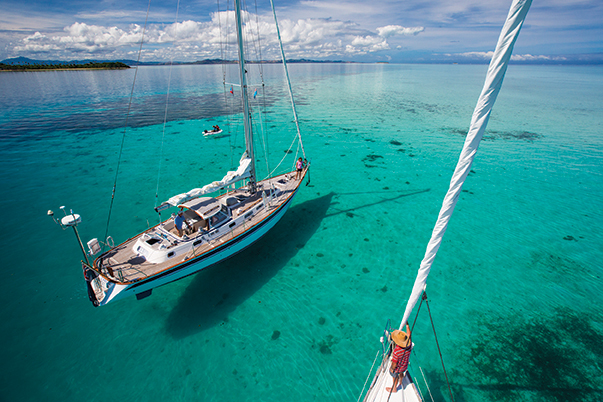
John Neal’s 313,000 offshore miles include six Cape Horn roundings plus voyages to Antarctica and Spitsbergen. Since 1976, John’s passion has been sharing his knowledge of ocean cruising and he has conducted more than 170 sail-training expeditions worldwide aboard Mahina Tiare III, a Hallberg-Rassy 46. When not at sea, John and Amanda are based on San Juan Island, where they enjoy wintertime kayaking. www.mahina.com

















